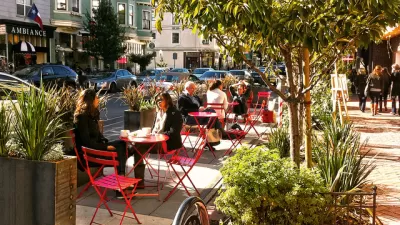Older, white homeowners take up far more than an equal share of the seats at the planning table in San Diego.

Andrew Keats shares news of new demographic analysis of the community planning groups that provide feedback on planning processes in San Diego, finding membership that trends whiter, older, and more affluent than the city as a whole.
Staff at the San Diego Planning Department conducted a first-of-its-kind survey to produce the results, which won't come as a surprise to the many advocates and observers who have spent decades pointing out the disparities in representation in planning processes.
"Nearly twice as many planning group members own a home as the city at large. The share of city residents between 20 and 29 is nearly five times greater than the share of planning group members. And white people make up nearly double the share of planning group members as they do San Diego residents," explains Keats more specifically about the findings of the survey.
The city is covered by 42 group elected boards, which represent specific geographic areas and review city planning decisions and private development proposals.
"Late last year, a City Council committee passed a series of reforms to the city’s planning groups," according to Keats. Though the Council adopted the policy outlining the groups in 1976, they’ve been under increasing scrutiny in recent years, with critical reports from the city auditor, county grand jury and a private housing advocacy group in 2018, and a legal memo from the city attorney last year that indicated the groups could be illegal as currently constituted.
In recent years, Portland, Oregon and Minneapolis have launched efforts to reform neighborhood planning organizations in response to similar disparities in those cities.
FULL STORY: Community Planning Groups Skew Richer, Whiter and Older

Study: Maui’s Plan to Convert Vacation Rentals to Long-Term Housing Could Cause Nearly $1 Billion Economic Loss
The plan would reduce visitor accommodation by 25,% resulting in 1,900 jobs lost.

North Texas Transit Leaders Tout Benefits of TOD for Growing Region
At a summit focused on transit-oriented development, policymakers discussed how North Texas’ expanded light rail system can serve as a tool for economic growth.

Why Should We Subsidize Public Transportation?
Many public transit agencies face financial stress due to rising costs, declining fare revenue, and declining subsidies. Transit advocates must provide a strong business case for increasing public transit funding.

How to Make US Trains Faster
Changes to boarding platforms and a switch to electric trains could improve U.S. passenger rail service without the added cost of high-speed rail.

Columbia’s Revitalized ‘Loop’ Is a Hub for Local Entrepreneurs
A focus on small businesses is helping a commercial corridor in Columbia, Missouri thrive.

Invasive Insect Threatens Minnesota’s Ash Forests
The Emerald Ash Borer is a rapidly spreading invasive pest threatening Minnesota’s ash trees, and homeowners are encouraged to plant diverse replacement species, avoid moving ash firewood, and monitor for signs of infestation.
Urban Design for Planners 1: Software Tools
This six-course series explores essential urban design concepts using open source software and equips planners with the tools they need to participate fully in the urban design process.
Planning for Universal Design
Learn the tools for implementing Universal Design in planning regulations.
Ascent Environmental
Borough of Carlisle
Institute for Housing and Urban Development Studies (IHS)
City of Grandview
Harvard GSD Executive Education
Toledo-Lucas County Plan Commissions
Salt Lake City
NYU Wagner Graduate School of Public Service





























